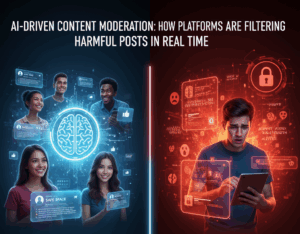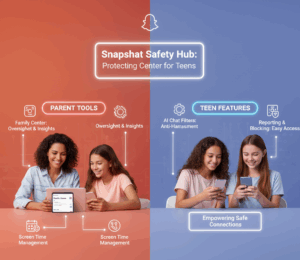Using Artificial Intelligence to protect the privacy of children on many platforms

Using Artificial Intelligence to protect the privacy of children on many platforms
Protecting the privacy of children has become an increasingly important concern for parents, teachers, and technology businesses as the number of children using digital platforms continues to rise. Data gathering, targeted advertising, and other online dangers are all things that young people are exposed to when they use social media, gaming applications, and messaging services. There are significant technologies available for improving safety via the use of AI monitoring; yet, it also raises problems of privacy, permission, and ethical bounds.
How the Monitoring of AI Operates
Artificial intelligence monitoring systems examine user behavior, messages, uploads, and interactions in order to identify information that may be harmful or unsuitable. A number of behaviors, including bullying, explicit material, predatory activity, and the sharing of sensitive information, may be identified by machine learning algorithms. After that, notifications are sent to the platform moderators, parents, or guardians so that they may take further action.
The Struggle Between Privacy and Safety
While artificial intelligence has the potential to shield children from potentially hazardous information, it must strike a balance between monitoring and protecting their right to privacy. Monitoring that is excessive may give the impression of being invasive and may also breach legislation about data privacy. Artificial intelligence monitoring must be conducted in a manner that respects user permission, anonymizes sensitive data, and only intervenes when it is absolutely essential.
Identifying Persons Who Prey Online
Patterns that are associated with predatory activity may be identified by AI systems. These patterns include recurrent interaction from adults who are unfamiliar to the user or improper demands. By identifying potentially exploitative behavior at an early stage, platforms have the ability to avoid possible exploitation and notify parents or authorities.
Controlling Content That Is Not Appropriate
It is common for children to be exposed to damaging media, such as material that is deemed adult, content that is violent, or hate speech. It is possible for artificial intelligence to automatically discover and delete such content, hence decreasing the need for continual human moderation and lowering exposure.
An Approach to Combating Harassment and Cyberbullying
The analysis of language, sentiment, and recurrent unfavorable interactions may also be used by AI monitoring to detect cases of cyberbullying. Through early diagnosis, platforms are able to intervene, alert caregivers, and offer support options for children who are afflicted by the condition.
Instruments for the Control and Reporting of Parents
Artificial intelligence is rapidly being integrated into parental dashboards, which provides parents and guardians with insight into their children’s online behavior without directly reading their children’s private conversations. It is possible for parents to take action or escalate issues while still preserving confidence via the use of reporting tools.
Matters with Ethical Implications
The monitoring of artificial intelligence presents ethical problems around the acquisition of data, permission, and the possibility of overreach. Platforms have a responsibility to guarantee that artificial intelligence does not unjustly target specific groups or generate prejudice, and they must also be honest about what is watched and how data is utilized.
The Working Together of Different Stakeholders
In order to safeguard the privacy of children, it is necessary for parents, educators, government authorities, and technology businesses to work together. It is vital, in order to construct a secure online environment, to establish clear criteria for the monitoring of artificial intelligence, the preservation of data, and safe use.
Fostering an Awareness of Privacy in Children
Technologies on their own are not adequate. For children to be able to defend themselves and make choices that are based on accurate information when using digital platforms, it is important to educate them about privacy, responsible sharing, and the threats that they face online.
Towards the Future Paths
Real-time threat identification, predictive safety measures, and context-aware moderation will all see improvements as a result of advancements in artificial intelligence. Artificial intelligence models that protect users’ privacy might make it possible to monitor without exposing sensitive information, so making online environments safer for youngsters.
Monitoring using artificial intelligence has the potential to be an effective instrument for safeguarding children by identifying improper information, cyberbullying, and predatory conduct. Nevertheless, its implementation has to be struck a balance between ethical concerns, preservation of privacy, and open communication with caregivers and children. We are able to develop a more secure digital environment for children by merging artificial intelligence technology with education and responsible platform regulations. This will allow children to explore, learn, and communicate without the need for excessive risk.





